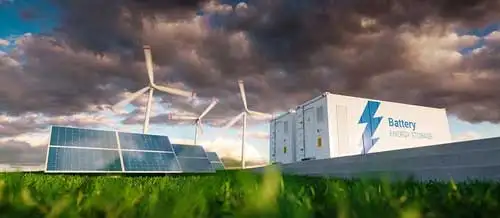The Future of Energy: Growth in Utility-Scale Energy Storage

The growth of utility-scale energy storage (ES) is rapidly transforming the energy industry. Developers and power plant owners are investing in ES projects to meet the growing demand for renewable energy, improve grid stability, and reduce greenhouse gas emissions. The deployment of large-scale battery projects worldwide is helping to transform the energy industry, reducing the reliance on fossil fuels and integrating renewable energy sources into the grid. With supportive policies and regulations, the growth of utility-scale ES is expected to continue, driving the transition towards a more sustainable energy future.
How does utility-scale battery storage work?
Utility-scale battery storage involves deploying large-scale battery systems at the utility level. These systems have a capacity of several megawatts or more and can store energy on a large scale. The energy stored in these batteries can be released back into the grid during periods of high demand or when there is a disruption in the grid. The energy stored in utility-scale battery storage systems can also be used to integrate renewable energy sources into the grid by storing excess energy during periods of high generation and releasing it back into the grid during periods of low generation.
What is the size of the utility-scale battery storage market?
The utility-scale battery storage market is rapidly expanding, driven by the growing demand for renewable energy sources and the need for reliable energy storage systems (ESS), according to a report by BloombergNEF, the global utility-scale battery storage market is expected to grow from 4.5 GW in 2020 to 63 GW by 2030.
What is utility-scale storage?
Utility-scale storage refers to large-scale ESS deployed at the utility level. These systems can store energy on a large scale, providing backup power during periods of high demand or when there is a disruption in the grid. Utility-scale storage can also help integrate renewable energy sources into the grid by storing excess energy during periods of high generation and releasing it back into the grid during periods of low generation.
What are the benefits of utility-scale energy storage?
Utility-scale ES has numerous benefits, including:
- Improving grid stability: ESS can help stabilize the grid by providing backup power during periods of high demand or when there is a disruption in the grid.
- Integrating renewable energy: ESS can help integrate renewable energy sources into the grid by storing excess energy during periods of high generation and releasing it back into the grid during periods of low generation.
- Reducing greenhouse gas emissions: ESS can reduce the need for fossil fuel-based generation, reducing greenhouse gas emissions and improving air quality.
- Enhancing energy efficiency: ESScan help reduce energy waste by storing excess energy during periods of low demand and releasing it back into the grid during periods of high demand.
What factors are driving the growth in utility-scale energy storage?
The growth in utility-scale ES is being driven by several factors, including:
- Increasing demand for renewable energy sources
- Declining costs of ESS
- Improving ES technologies
- Supportive policies and regulations
- Growing investment from developers and power plant owners
How is the development of new energy storage technologies impacting the growth of utility-scale storage?
The development of new ES technologies is significantly impacting the growth of utility-scale ES. Solid-state batteries, flow batteries, and other advanced battery technologies are being developed to improve performance and reduce the cost of ESS. These technologies offer higher energy density, longer lifespan, and improved safety compared to traditional lithium-ion batteries.
What are the key challenges facing the growth of utility-scale energy storage?
The growth of utility-scale ES has its challenges. For example, the chain for ESS is complex, and there are concerns about the availability of critical materials such as lithium and cobalt. In addition, deploying utility-scale ESS can be challenging due to regulatory hurdles, high upfront costs, and the need for supportive policies and regulations.
How are energy storage projects being financed, and how does this impact growth?
ES projects are financed through various mechanisms, including private investment, government funding, and incentives. The availability of financing and the cost of capital can significantly impact the growth of energy storage projects. The financing of energy storage projects is becoming more accessible as the cost of energy storage systems continues declining and supportive policies and regulations are implemented.
What role will energy storage play in integrating renewable energy into the grid?
ES will be crucial in integrating renewable energy into the grid. Renewable energy sources such as wind and solar are intermittent, meaning their output can vary depending on weather conditions. ESS can store excess energy during periods of high generation and release it back into the grid during periods of low generation, helping to balance the supply and demand of electricity. This can help integrate renewable energy sources into the grid, reducing the need for fossil fuel-based generation and improving grid stability.
What policies and regulations are being implemented to support the growth of utility-scale energy storage?
Governments and regulatory bodies worldwide are implementing policies and regulations to support the growth of utility-scale ES. These policies and regulations include creating funding programs and incentives, developing standards and regulations for energy storage systems, and implementing mandates for renewable energy targets.
The Gateway Energy Storage System in California is an example of a utility-scale ES project helping transform the energy industry. The Gateway ESS is a 250 MW/1 GWh ESS deployed by LS Power in 2020. This project is one of the world's most significant ES projects and can power up to 250,000 homes for four hours.
Utilizing utility-scale battery projects ranging from tens to hundreds of megawatts is becoming increasingly common worldwide, particularly in countries such as China, the United States, and Australia. These projects are crucial for the growth of utility-scale ES and are helping to transform the energy industry.
On-Site Training
Interested in cost effective, professional on-site electrical training?
We can present an Electrical Training Course to your electrical engineering and maintenance staff, on your premises, tailored to your specific equipment and requirements. Click on the link below to request a Free quotation.
EF PARTNER MEDIA
Product Showcases
Shared Media
























